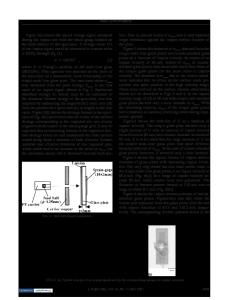Measurement of local strain
- PDF / 1,598,836 Bytes
- 6 Pages / 585 x 783 pts Page_size
- 4 Downloads / 377 Views
Introduction Strain is a key parameter controlling various physical phenomena coupled to the electronic band structure and defect distribution in materials. Local strains can be used to modify material properties as well as mechanical strength or the lifetime of the material.1 Measuring and controlling the strain at the nanoscale is fundamental for tailoring both functional and mechanical properties. Elastic strain engineering is widely used in the semiconductor industry to improve the performance of modern devices.2 Strain fields are getting increasingly complex, showing nanoscale nonuniform distributions, requiring measurement techniques with high spatial resolutions. Similarly, local stresses around individual defects and their behavior during deformation are the fundamental factors determining the mechanical response of a material, requiring knowledge of the local elastic strain over time.3 Elastic strain is fundamentally the displacement of individual atoms from their relaxed position, and its components are directly linked to the stress components via the elasticity constants.4 These stresses and strains are not easy to determine, as variances in chemical composition influence the atomic distances, and manufacturing processes induce locally varying residual stresses. A quantitative stress and strain measurement therefore often requires certain assumptions (such as a
stable local composition), and only allows for relative measurements. The local elastic strain can only be evaluated with respect to a reference region, which is assumed to be relaxed. This allows for the measurement of relative local changes in lattice parameters. Furthermore, if the investigated material is being deformed, a distinction has to be made between elastic strain related to local distortions of the lattice and plastic strain. The local elastic strains occurring during deformation are directly related to the local stresses; it is important to note that they are transient and thus have to be measured in situ during loading of the specimens.5 A wide range of strain mapping techniques have been developed, which can be divided into imaging techniques and diffraction techniques. The local plastic strain can be determined by digital image correlation (DIC). This technique tracks multiple features to map the local plastic distortion in the sample.6 Using transmission electron microscopy (TEM), atomic resolution can be achieved by imaging atomic columns, which directly determines the local elastic strain from the lattice distortions.7,8 Most frequently, however, diffraction techniques are used to measure the local elastic strain, using the Bragg relation that directly links the positions of diffraction peaks to the lattice parameters. This includes the use of x-ray diffraction (XRD),1 neutron diffraction,9 and electron diffraction.8
Christoph Gammer, Erich Schmid Institute of Materials Science, Austrian Academy of Sciences, Austria; [email protected] Marie-Ingrid Richard, Aix-Marseille University and IM2NP, France; [email protected]
Data Loading...









